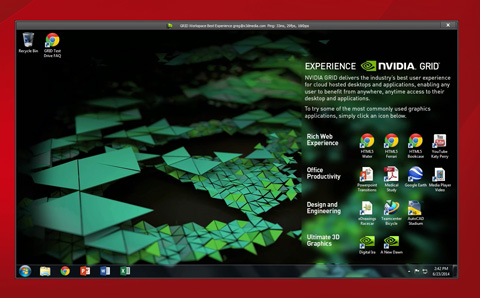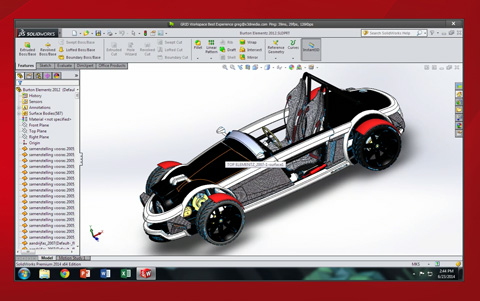
The Nvidia GRID Test Drive virtual desktop
Nvidia has launched the GRID Test Drive, a simple and secure way to test out your very own graphics-accelerated virtual desktop – CAD in the cloud, if you like.
With this proof of concept all of the processing is done on the cloud-based virtual machine and only pixel data is streamed to your local desktop. Mouse and keyboard input is sent back.
It’s very easy to get up and running with the free trial. Simply sign up for the service, download the Nvidia GRID workspace (Windows) client, log in and away you go. The whole process takes a couple of minutes.
Once registered you are given remote access to your very own virtual workstation. The specification is pretty decent for CAD: 8 virtual CPU cores running at 2.6GHz, 15GB of system memory and one Nvidia GRID K520 GPU.
Once logged onto the virtual desktop, design and engineering users are presented with three apps to play around with – SolidWorks eDrawings, Teamcenter and AutoCAD. However, if you dig deeper into the system (Start button > Program files) you’ll find some more demanding 3D CAD and visualisation tools – Autodesk Inventor 2014, SolidWorks 2014 and Autodesk Showcase 2014 – at your disposal. Nvidia says you can also install your own applications, should you so desire.
Each app comes with some test files, but getting your own data onto the system is easy. Nvidia says you can drag and drop files from your real desktop to your virtual desktop, though this didn’t seem to work for us. Instead, we fired up a web browser, logged onto dropbox and pulled down some SolidWorks assemblies.

SolidWorks 2014 running on a virtual desktop in the cloud
We have to say we were very impressed with our test drive. Everything felt extremely responsive, with 3D models reacting instantly to our mouse movement. It didn’t feel like we were using a remote workstation – the experience was the same as if it was under our desk.
At the top of the GRID Workspace window the system gives real time updates about your GRID instance, including ping time to the GRID server, the current Frames Per Second (FPS) rate at which the GRID client is receiving streams from the server, and the current bandwidth usage of the network stream.
Our session hovered around 30ms and 30fps thanks to our decent 50Mb Internet connection (thanks Virgin Media). Nvidia says you should get a very good experience under 100ms and it’s even quite good at 200ms. Bandwidth should be in the order of 10Mb.
There are some limitations of the Nvidia GRID Test Drive.
The screen resolution is currently fixed at 1,366 x 768 on a single monitor, which is frustrating considering most CAD designers like to work in HD and often on multiple displays.
In an actual GRID deployment, Nvidia says screen resolutions of up to 2,560 x 1,600 can be supported and each VM can have up to 4 monitors connected.
We can understand why Nvidia has fixed at a relatively low resolution for this initial proof of concept. Relatively speaking, HD (1,920 x 1,080) has twice as many and 2,560 x 1,600 four times as many pixels as 1,366 x 768. Add multiple monitors into the mix and the number of pixels going down the pipe soon explodes.
Secondly, when testing with SolidWorks 2014, RealView was disabled so we couldn’t test out its full real time rendering capabilities. We presume this is because SolidWorks doesn’t recognize the GRID GPU as a certified graphics card.
The other important thing to point out is the trial states you get 24 hours to test it out, but we got chucked off after 2 hours, so use your time wisely. You can email Nvidia for more time, however.
Finally, while the client is currently only available for Windows, OS X and Linux clients will be coming soon. iOS and Android are a little further down the line, says Nvidia.
In conclusion, GRID Test Drive looks to be an excellent way to get a feel for ‘CAD in the Cloud’. Users ahead of the curve have traditionally had to build their own proof-of-concept private clouds, which can take weeks, if not months to get up and running. GRID Test Drive allows everyone to test out the tech, regardless of budget or skills.
There is some tweaking to do. Nvidia says its GRID card is being used in GPU passthrough mode, so it appears the GPU is not yet being virtualized. This means CAD users are being given access to far more graphics power than they’d be given in a real world GRID environment. We imagine this will change in the future.
Despite not being the most accurate testbed for CAD (limited resolution and lack of virtual GPU) it’s an impressive start nonetheless. Nvidia GRID is certainly an exciting technology and we look forward to seeing Nvidia push its capabilities and better tune the system to real world use cases in the future.
Nvidia currently has servers in the US, Europe and Asia and the test drive is available now across the UK, China, Taiwan and North America. Register here
Meanwhile, check out Openboundaries, who is currently running its own proof of concept to see how GRID technology works with genuine CAD workflows – modelling, blend/fillet, extrude, etc – not just viewing parts.
OpenBoundaries uses Citrix and Nvidia GRID technologies and hopes to gain insight into how its remote delivery systems are sized, benchmarked and optimised.






